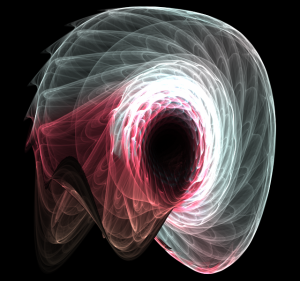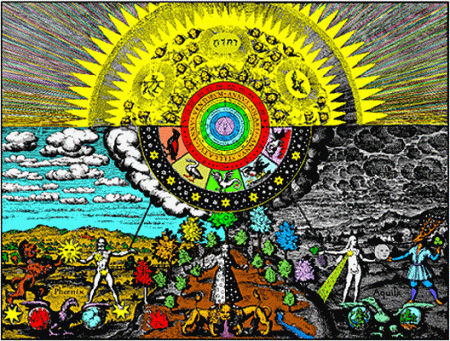
Robert Fludd, The Great Chain of Being from God to Nature and from Nature to Man, from Utriusque cosmi maioris scilicet et minoris metaphysica, physica atque technica historia 1617-1618. Wellcome Library, London. Copyrighted work available under Creative Commons.
Cosmos
For the Pythagoreans kósmos expressed a sense that the world as a whole was pervaded by intelligent order, beauty, and structural perfection. Robert Fludd’s seventeenth century illustration of the Great Chain of Being (above, and discussed here) in which a prominent female figure representing Nature wears a small Sun and Moon on her breasts, is held on a chain by a celestial God, and holds an ape representing ‘art’, or perhaps the alchemist, on a chain below her, should suffice to remind us that images of totality emanate from a particular perspective. The power dynamics inherent in such unifying visions have been much discussed, of course.
In Cosmos and Psyche (2006) Richard Tarnas responded to postmodern sensibilities by envisioning ‘a cosmic ordering principle whose combination of participatory co-creativity, multivalent complexity, and dynamic indeterminacy’ would not have been comprehensible to Plato. Because the world now appears more responsive to human intention and consciousness our conception of cosmos needs to incorporate a correspondingly fluid, complex, and unpredictable relationship with ‘a dynamic archetypal order’.(1) We might wonder whether postmodernity renders the term cosmos redundant, but my own experience of astrology inclines me to agree that the sense of pattern, order, and structure implied by the term is at least as fundamental to the unfolding of lives (the microcosm) within the matrix of chaosmic Nature (the macrocosm), as contingency, complexity, sponteneity, humour, randomness, and surprise.
Tarnas argued for a post-Jungian archetypal astrology by amassing evidence in the form of correlations between planetary cycles and cultural and historical developments in the history of the West. Despite his description of archetypes as multidimensional (having a formal coherence and consistency that can give rise to many manifestations and meanings) and multivalent (we may relate to them actively or passively) I’m still not comfortable with an essentialising and universalising impetus, and depersonalising tone (c.f. powers or deities) inherent in the concept however.*
Tarnas’ discussion of the cultural importance of the Copernican revolution illuminates the genealogy of how ‘we’ in the late modern West have come to think about cosmos: ‘To have it suddenly dawn on one that the great Earth itself, the most obviously stationary and immovable entity in the cosmos, upon which one had lived in changeless solidity all one’s life, was in fact at that moment moving freely through space […] no longer the absolute fixed centre […] but rather a planet, a wanderer, an exalted celestial body in a new cosmos whose dimensions and structure and meaning were now utterly transfigured; such a revelation must have filled the mind and spirit with an awe seldom known in human history’.(p5)
This most radical of discoveries ’emancipated the modern self from a cosmos of pregiven meanings’ and affirmed confidence in human rationality whilst simultaneously disrupting a longstanding illusion that the cosmos revolved around the earth, and the needs of humankind in particular. The subsequent Cartesian revolution that radically separated soul from body, and subject from object, and the ‘Copernican revolutions’ of Kant, who attributed the apparent temporal, spatial, and causal order of the world to the interpretive structure of the perceiving mind, and Darwin, who located humans within an evolutionary framework, along with Freud’s diminishment of the rational ego, further decentred the human in a cosmic context. Western modernity responded by relocating intelligence, soul, spirit, meaning, and purpose, exclusively in the human self, thereby progressively disenchanting the world.(2)
While reading this it occured to me that Freud wasn’t the first to link Copernicus with transformations in the ‘inner cosmos’.(p44) Nietzsche, whose writings prefigured depth psychology, dramatised the significance of the new cosmology in the voice of a madman confronting the death of God and the onset of nihilism, and in his Genealogy of Morals wrote: “Ever since Copernicus man has been rolling down an incline, faster and faster, away from the centre-whither? Into the void? Into the ‘piercing sense of his emptiness’?(3).
Tarnas identified the modernist assumption that any ‘apparent’ meaning or purpose in the universe must have been constructed and projected on to it by the human mind as ‘hubris of cosmic proportions’. In an epilogue, however, he ventured the hardly less anthropocentric suggestion that the creative, unpredictable, and fallible ‘self-reflective human being’ may be ‘a unique vessel and embodiment of the cosmos’.(p492)
Although Cosmos and Psyche was the fruit of extensive collaboration Tarnas has been taken to task for making only a brief passing reference to the work of other astrologers. Having defended astrology against the prejudice of modernity he no doubt felt that citing actual astrological texts would jeapordise the chance of his work being taken seriously by the mainstream. He also, perhaps again understandably, overlooked scholars who have taken ‘cosmos’ in a naturalistic direction -notably Alexander von Humboldt, who is widely acknowledged as having bought the term into the modern world- and Carl Sagan, both of whom also attempted the kind of comprehensive and integrative account that a cosmic perspective has long seemed to demand.
And therein lies a familiar problem, namely the privileging of a lone commentator’s apparently impartial panoramic viewpoint. My feeling is that Tarnas could have said a bit more about the difficulties associated with the uses and misuses of astrology, and about the situated, partial, provisional, and contestable, nature of astrological interpretations.

Tabula Smaragdina, Macrocosm and microcosm. Engraving attached to Basilica Philosophica, 3rd vol of Johann Daniel Mylius, Opus Medico-Chymicum. 1618. Matthaus Merian.
Towards the end of his life Alexander von Humboldt wrote Cosmos, A Sketch of a Physical Description of the Universe, a five volume account of Nature encompassing phenomena from aurorae, through climatic and vegetation zones on earth, to algae, landscape painting, and poetry, whose index alone makes Richard Tarnas’s 569 page opus look like a slim pamphlet. In October 1834 he declared “the mad frenzy has seized me of representing in a single work the whole material world.” The result was a massive collaborative synthesising project.
Though Humboldt made no mention of God or spirituality, his sense of wonder, and the importance of aesthetic and emotional engagement, meant that he was taken up by the American transcendalists and English romantics as well as by scientists such as Darwin. Interestingly, his faith in the stability of nature was shaken by an earthquake in South America. No longer could he assume that water rather than earth was the element of motion. Unlike most scientists of his time who focussed on taxonomic classification, Humboldt sought to integrate detailed empirical measurement with a holistic vision of nature as an interconnected web and global force. As well as undertaking meticulous surveys, he acknowledged that ‘what speaks to the soul escapes our measurement’ and found that ‘nature everywhere speaks to man in a voice familiar to his soul’.(4)
Not least because Humboldt wrote prescient accounts of the effects of deforestation and human induced climate change in South America two hundred years ago, he is now celebrated as a proto-ecologist. His sense of reciprocity between the human mind and nature informs contemporary definitions of cosmos and cosmopolitics that emphasise communal, participatory, and collective aspects, and relations between human communities and an agentic nonhuman world. In a move that would no doubt surprise some of Plato’s feminist critics Laura Dassow Walls has reclaimed cosmos as ‘humanity’s oldest ecological vision of our planet’.(5) Whereas Plato’s cosmos privileged God and Reason and signified an over-arching ordering vision inspired by a Divine Intellect, recent understandings interpret cosmology from a human perspective in terms of stories about our individual and collective place in the universe.
Humboldt’s encounter with indigenous people’s cosmovisions is said to have shaped anthropology, ethnography, and environmentalism (not least through the cosmography of Franz Boas). For Bruno Latour cosmos is synonymous with “the common good world” -a world in which ‘cosmopolitics’ brings together a pluriverse of peoples and natures living in ‘a commons resilient enough to embrace the future.’ Cosmopolitics of this kind is exemplified by the World People’s Conference on Climate Change and the Rights of Mother Earth, held in Bolivia in 2010, where representatives from the Global South and many Indigenous groups presented a Universal Declaration on the Rights of Mother Earth (UDRME, 2010). Their decalaration stated that “indigenous peoples, nations, and organizations ancestral ‘cosmovisions’—thousands of years in the making […] conceive of Earth as a ‘person’ or ‘living being with whom [all persons] have an indivisible and interdependent relationship”. A working Group on Indigenous Peoples identified ‘aggression toward Mother Earth‘ as ‘an assault on us’ -meaning all human groups and all other ‘persons,’ including the ‘soils, air, forests, rivers, [and] lakes’ (‘Final Conclusions’ 2010, parag. 2).” (Monani and Adamson, 2016:4, citing Latour 2014).
Megalithic astronomy confirms that the human impulse to orient ourselves in relation to cosmic nature is both ancient and widespread. Across the over developed world this powerful impulse lives on in folk dance, communal rites, and the quiet alchemy of contemplative practice, that may honour the cardinal directions, visible stars, or phases of the Moon, and affirm our interdependence with the living land and a teeming diversity of other-than human life. Ronald Grimes writes that ‘ritual is the predication of identities and differences (metaphors) so profoundly enacted that they suffuse bone and blood, thereby generating a cosmos (an oriented habitat). In rites we enact a momentary cosmos of metaphor”.(6).
B.T. 10th January 2017.
*ref ‘archetype’, I prefer to think in terms of story and relationship, but if an astrological equivalent were needed planetary principle should suffice (see Mike Harding, Hymns to the Ancient Gods).
Sources:
(1) Richard Tarnas, Cosmos and Psyche, Intimations of a New World View, Plume, 2007 pp73 and 489.
(2) Richard Tarnas, A New Synthesis, Resurgence, 199 March-April 2000, and see here.
(3) Frederick Nietzsche The Genealogy of Morals, Anchor/Doubleday, 1887/1956:291-2. See also Frederick Nietzsche The Gay Science, New York, Vintage Books 1882/1974:181-2
(4) Andrea Wulf, The Invention of Nature, the Adventures of Alexander von Humboldt the Lost Hero of Science, John Murray, 2015 pp54,72,235.
(5) Laura Dassow Walls, The Passage to Cosmos; Alexander von Humbolt and the Shaping of America, University of Chicago Press 2009.
(6) Ronald Grimes, Performance is Currency in the Deep World’s Gift Economy, in Graham Harvey ed. The Handbook of Contemporary Animism, Acumen, 2013.
Bruno Latour, 2004. “Whose Cosmos, Which Cosmopolitics? Comments on the Peace Terms of Ulrich Beck.” Common Knowledge 10 (3): 450–62.
Salma Monani and Joni Adamson, Ecocriticism and Indigenous Studies, Conversations from Earth to Cosmos, Routledge, 2016.
Laura Dassow Walls. (2009) The Passage to Cosmos: Alexander von Humboldt and
the Shaping of America, Chicago, IL: University of Chicago Press.
Laura Dassow Walls. (2015) “Cosmos.” In Keywords for Environmental Studies, eds. Joni Adamson,
William A. Gleason, and David N. Pellow, 47–50. New York: New York University Press.





